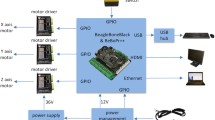Abstract
Modern magnetic resonance imaging (MRI) systems consist of several complex, high cost subsystems. The cost and complexity of these systems often makes them impractical for use as routine laboratory instruments, limiting their use to hospitals and dedicated laboratories. However, advances in the consumer electronics industry have led to the widespread availability of inexpensive radio-frequency integrated circuits with exceptional abilities. We have developed a small, low-cost MR system derived from these new components. When combined with inexpensive desktop magnets, this type of MR scanner has the promise of becoming standard laboratory equipment for both research and education. This paper describes the development of a prototype desktop MR scanner utilizing a 0.21 T permanent magnet with an imaging region of approximately 2 cm diameter. The system uses commercially available components where possible and is programmed in LabVIEW software. Results from 3D data sets of resolution phantoms and fixed, newborn mice demonstrate the capability of this system to obtain useful images from a system constructed for approximately $13 500.
Similar content being viewed by others
References
Balaban RS, Hampshire VA. Challenges in small animal noninvasive imaging. ILAR J 2001;42(3):248–62.
Haishi T, Akita Y, Kose K. MR microscopy of mice at 1.0 Tesla. Proc Int Soc Magn Reson Med 2000;8:1383.
Kose K, Haishi T, Nakanishi A, Okada S, Tsuzaki T. Development of a desktop MR microscope using a small permanent magnet. Proc Int Soc Magn Reson Med 2000;8:1380.
Rokitta M, Rommel E, Zimmerman U, Haase E. A portable NMR imager. Proc ESMRMB 1999;16:528.
Haase A, Rokitta A, Rommel E. NMR portable imager. Proc Int Soc Magn Reson Med. Workshop on MRI Hardware, Cleveland, 23–25 February 2001. p. 23.
Wright SM, Brown DG, Spence DC. NMR Hardware and Desktop Systems. Fourth Mexican Symposium on Medical Physics, vol. 538. American Institute of Physics Conf. Proc. 2000. p. 112–8.
Conolly S et al. Prepolarized magnetic resonance imaging. Proc Int Soc Magn Reson Med. Workshop on MRI Hardware, Cleveland, 23–25 February 2001. p. 22.
Macovski A, Conolly S. Novel approaches to low-cost MRI. Magn Reson Med 1993;30(2):221–30.
Scott G, Xu H, Conolly S, Macovski A. Single conversion image reject receiver for low-field MRI. Proc Int Soc Magn Reson Med 1997;5:60.
Prado PJ, Blumich B, Schmitz U. One-dimensional imaging with a palm-size probe. J Magn Res 2000;144(2):200–6.
Seeber DA. Toward micron resolution proton magnetic resonance imaging of biological cells. Proc. Int. Soc. Magn. Reson. Med. Workshop on MRI Hardware Cleveland, 23–25 February 2001.
Magin RL, Webb AG, Peck TL. Miniature magnetic resonance machines. IEEE Spectrum 1997;34(10):51–61.
Cole DM, Esparza E. Huson FR, Wright SM, Elekes A. Design improvements for permanent magnet-based MRI. Proc Ann Mtg Soc Magn Reson 1997;2:1079.
Esparza E, Cole DM. A low-cost MRI permanent magnet prototype. Second Mexican Symp on Med Physics. American Institute of Physics Conf. Proc. vol. 440, 1998. p. 119–29.
Brown DG, Spence DC, Wright SM. A transceiver for an inexpensive desktop MR microscope. CD-ROM Proc of the World Cong on Med Phys and Biomed Engineering, TH-BA-205–4, 2000.
Thornton J. Instrumentation for low cost, small volume magnetic resonance imaging. Proc Soc Magn Reson Med 1993;12:1315.
Anderson W. Electrical current shims for correcting magnetic fields. Rev Sci Instrum 1961;32(3):241–50.
Black RD, Early TA, Roemer PB, Mueller OM, Mogro-Campero A, Turner LG, et al. A high-temperature superconducting receiver for nuclear magnetic resonance microscopy. Science 1993;259(5096):793–5.
Hurlston SE, Brey WW, Suddarth SA, Johnson GA. A high-temperature superconducting Helmholtz probe for microscopy at 9.4 T. Magn Reson Med 1999;41(5):1032–8.
Miller JR, Hurlston SE, Ma QY, Face DW, Kountz DJ, Mac-Fall JR, et al. Performance of a high-temperature superconducting probe for in vivo microscopy at 2.0 T. Magn Reson Med 1999;41(1):72–9.
van Heteren JG, James TW, Bourne LC. Thin film high temperature superconducting RF coils for low field MRI. Magn Reson Med 1994;32(3):396–400.
Wright AC, Song HK, Wehrli FW. In vivo MR micro imaging with conventional radiofrequency coils cooled to 77 degrees K. Magn Reson Med 2000;43(2):163–9.
Cugat O, Bloch F. The 5 Tesla sphere. http: magnet.ee.umist.ac.uk/reports/P14/p14_2.html.
Peck TL, Magin RL, Kruse J, Feng M. NMR microspectroscopy using 100 microns planar RF coils fabricated on gallium arsenide substrates. IEEE Trans Biomed Eng 1994;41(7):706–9.
Peck TL, Magin RL, Lauterbur PC. Design and analysis of microcoils for NMR microscopy. J Magn Reson B 1995;108(2):114–24.
Author information
Authors and Affiliations
Corresponding author
Rights and permissions
About this article
Cite this article
Wright, S.M., Brown, D.G., Porter, J.R. et al. A desktop magnetic resonance imaging system. MAGMA 13, 177–185 (2001). https://doi.org/10.1007/BF02678594
Received:
Revised:
Accepted:
Issue Date:
DOI: https://doi.org/10.1007/BF02678594




